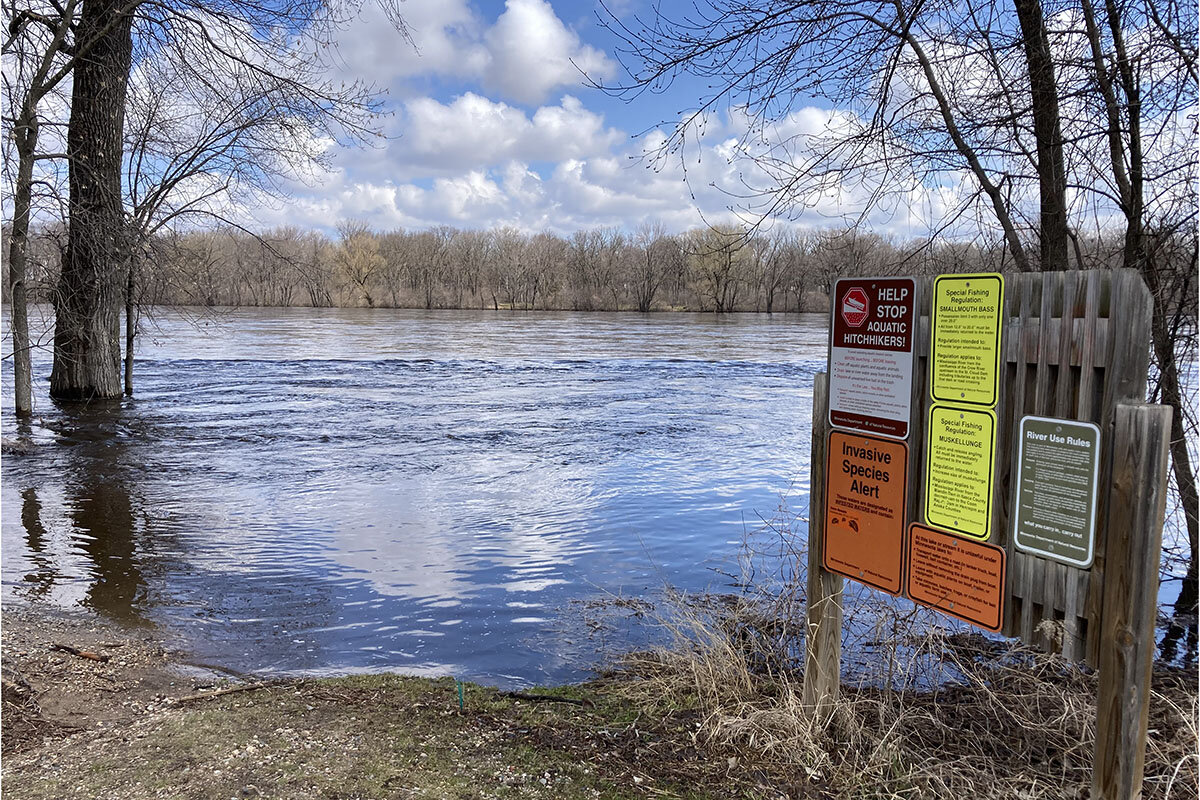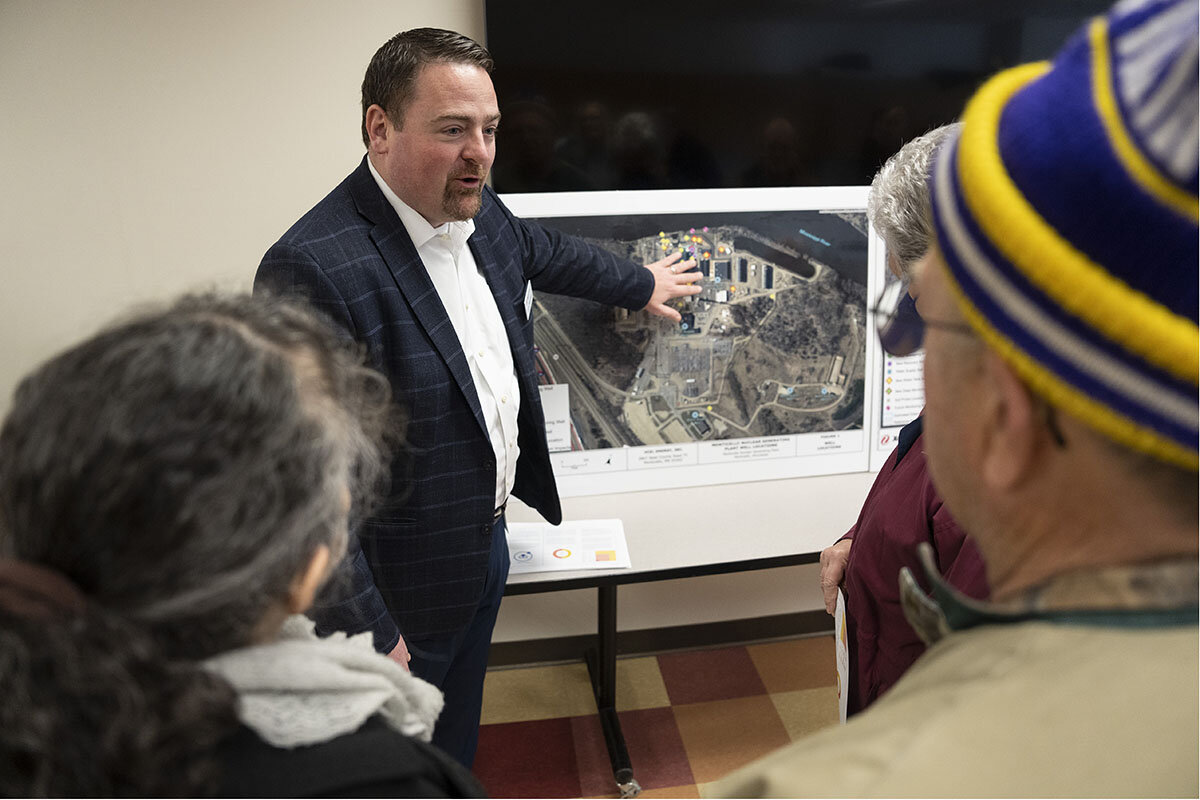Is nuclear power attractive or risky? In Minnesota, it’s both.
Loading...
| Monticello, Minn.
At a clearing in the brush, a clunky wooden dock is still pulled onshore for the season amid piles of dirty snow. Usually, this boat landing at the Montissippi Regional Park is a popular spot for amateurs to fish bass and walleye from the Mississippi River.
But after the Xcel Energy nuclear plant – just half a mile away – announced in March that radioactive material had leaked twice from a faulty pipe since November, some locals say they’re worried about what’s in the water.
“I’m more reluctant to put my line in the river now. I don’t know if it’s safe,” says Chuck, a Monticello resident who came to the park to play disc golf with friends. Chuck’s father worked at the nuclear plant for decades before leaving on bad terms (and for this reason, the son declines to give his last name). “I haven’t taken the boat out yet this season, but I’ll definitely be fishing upstream this year.”
Why We Wrote This
A story focused onIn the Minnesota legislature, views on nuclear power once cleaved largely along party lines. Now climate change is shifting that pattern, but a radioactive leak has rekindled public concerns about safety.
The Minnesota Pollution Control Agency and Minnesota Department of Health say the risks to the public from the leaks of water contaminated with tritium – totaling a little more than 400,000 gallons – are minimal and have not affected public drinking water. Xcel Energy powered down its Monticello plant in mid-March for maintenance, once the second leak had been discovered.
That has done little to assuage the fears of local residents, however, who say the utility company should have notified the public earlier about the leak.
As Minnesota joins a growing number of states with ambitious clean-energy goals – it recently passed legislation to go 100% carbon-free on electricity by 2040 – more climate advocates and politicians are saying they cannot get there with traditional renewables alone. That’s prompting a renewed push for nuclear energy, even among former skeptics. Yet building public trust remains a key challenge, in Minnesota and across the nation – particularly in the wake of incidents like the one in Monticello.
“Right now, there isn’t a single cheap, reliable renewable energy. Each of the technologies has its strengths and weaknesses,” says Kevin Pranis, marketing manager for the Minnesota-North Dakota branch of Laborers’ International Union of North America, which represents over 12,000 workers. “As we’re looking at how you build a low- or zero-carbon economy, nuclear seems like an essential tool.”
Reliance, but also restrictions
The U.S. gets approximately 19% of its electricity from nuclear power, according to the Energy Information Administration. While states need to go through the federal Nuclear Regulatory Commission (NRC) for licensing approval, much of the challenge of building nuclear energy plants or considering new nuclear technologies is getting past state legislation.
Minnesota – which gets 24% of its electricity from two nuclear power plants – is one of 12 states that currently have a moratorium on the construction of new nuclear power facilities. That has led proponents here to focus their efforts instead on the latest technologies, like small modular reactors – which have a smaller physical footprint than conventional reactors and are seen by many as the future of nuclear energy, based on cost and relative safety.
“We’re being technologically agnostic,” says Democratic state Sen. Tou Xiong. “We want to take a wide approach and look at ways to reach our climate goals, given what we have. And we do have nuclear power here in Minnesota.”
Senator Xiong is part of a bipartisan group backing a bill – which he hopes will pass this month – that puts $300,000 toward research on the environmental and health impacts, costs, and energy benefits of advanced nuclear reactor designs. He says that in the past five years, more Minnesota Democrats have come around to the idea of nuclear energy – an issue that once split along party lines.
This mirrors a wider national trend. In 2023 alone, there have been close to 100 bills across 20 states to repeal moratoriums or study nuclear energy, according to the Nuclear Innovation Alliance, based in Washington, D.C. The U.S. Department of Energy recently invested nearly $2 billion in TerraPower’s construction of a nuclear reactor in Kemmerer, Wyoming, to replace a retiring coal plant. And John Kerry, the special presidential envoy for climate, has openly supported nuclear energy as a tool to fight climate change.
“When we’ve done clean-energy modeling, the first 60% or 70% of decarbonization is fairly straightforward,” says Patrick White, project manager at the alliance. “But to reach more than 80% or 90%, balancing out your energy system gets a lot more challenging. ... It’s about what makes sense for each state and how serious we are about hitting our climate goals. What works in Florida may not work in Minnesota.”
Evolving concerns on safety
That’s not to say there aren’t concerns about nuclear from within the climate advocacy community. With the exception of the Vogtle plant in Burke County, Georgia – which boasts next-generation technology – the U.S. reactor fleet is of the same or similar generation as the one involved in Japan’s Fukushima disaster in 2011.
“Whether they’re identical in design or not, they all have the same level of vulnerability,” says Edwin Lyman, a physicist and the director of nuclear power safety at the Union of Concerned Scientists, a national watchdog.
He says that nuclear plants always emit some radiation under normal operations, but this is regulated by the NRC.
“You could argue whether those limits are in the right place, but they’re designed to keep the level of harm below a certain threshold. The most serious risk to the public comes from those catastrophic events, like Fukushima, which are low probability but no one can say how low. How safe is safe enough?”
Dr. Lyman says the Biden administration, in its enthusiasm to tackle carbon emissions and roll out new nuclear plants, must be careful not to forgo needed safety rules. That becomes even more essential as climate change brings higher winds and flooding, the biggest risks for a reactor short-circuit. Nuclear operators have also struggled with how to store waste long term. New waste is stored in pools before being transferred to dry casks, which can take up land space indefinitely.
But to climate advocates who support nuclear, innovation inspires hope.
“I think people are coming to the conclusion that we have a long way to go [in meeting our clean-energy needs],” says Eric Meyer, the executive director of Generation Atomic, a nonprofit in Minnesota’s state capital, St. Paul. “We can’t put all our eggs in one basket.”
Mixed feelings by the Mississippi
The public seems to be on board with putting more time and research into nuclear energy. According to an April Gallup poll, 55% of Americans support nuclear energy, the highest level in a decade.
But for those living near nuclear plants, there are still concerns about safety and security – from the quality of groundwater to the threat of domestic terrorism. Out on the trail at Montissippi Regional Park in Monticello, locals joke that their tomatoes are extra large thanks to their proximity to the Xcel plant. Others say they’ve been drinking bottled water since the leak.
“When those Chinese surveillance balloons flew overhead [in February], I did wonder, would the nuclear plant be a target?” says Betty, out for a walk with her husband Jack. Betty used to work for the city of Monticello and did not want to identify herself by her full name.
While the immediate risks may be small, she says she and her husband “live in the shadow of the nuclear plant,” which is a half mile from their house. Every year, Xcel Energy distributes a free calendar, which includes evacuation information in the event of disaster.
To get beyond fear and misinformation, Xcel Energy held two community meetings last month in Monticello in the wake of the tritium leak, in hopes of bridging the communication gap – now and in the future.
“We’re having a dialogue with the city to figure out how to provide less mystery,” says Chris Clark, the president of Xcel Energy Minnesota, South Dakota, and North Dakota. “And in the event that something happens, how to explain what’s happening at the plant without creating unnecessary concern.”
A few miles down from the park at the Monticello Community Center, locals say they’re more preoccupied by politics and issues like artificial intelligence than nuclear energy. But the Xcel plant is never far from thought.
“I live upstream so I’m not that worried,” says Karen Hanson, from neighboring Albertville. “But if I lived downstream, I might think differently.”
Her friend Alice Kantor, who lives across the road from the Xcel plant, says she isn’t adamantly for or against nuclear energy and would welcome more information about it from local leaders.
“I’m always for advances,” says Ms. Kantor, running the table at a Sunday breakfast fundraiser for the Monticello Senior Center. “If nuclear is the best thing, then we should pursue it.”








